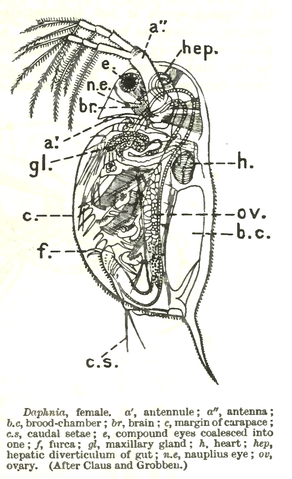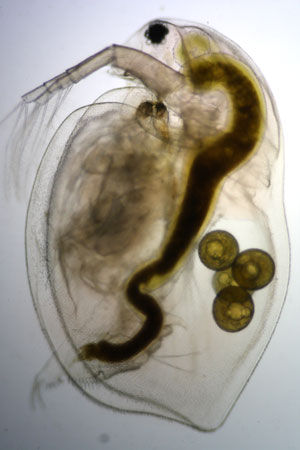Water flea Daphnia pulex
Materials
- Glass microscope slides with pre-prepared chamber of electrical tape
- Plastic cover slips
- Paper towels or tissues
- Pasteur pipette or dropper
- Daphnia pulex collected from a pond/stream or acquired comercially
- Petri dish (optional)
See information on suppliers here.
Methods
- Suck up some of the water containing Daphnia with the dropper or pipette and place in a petri dish if available (if not, proceed to 3). This can by tricky for small children, but is fun trying.
- Look at the Daphnia with a stereomicroscope if available.
- Place the Daphnia (in a small drop of water) in the microscope slide with the preprepared tape chamber.
- Gently place a coverslip on top of the Daphnia without pressing. The Daphnia should live for a while like this, as long as there is the right amount of water on the slide. View with 4x or 10x objectives on a compound microscope and adjust focus carefully to see different features.
TIPS: Many features of the Daphnia are spectacular, but special attention should be paid to the beating heart, eyes and surface of the animal (where individual cells are clearly visible).

Females do not need always need a male to have offspring; they can have babies on their own!
Daphnia are small, planktonic crustaceans, which are commonly called water fleas because of their swimming style. They live in various aquatic environments ranging from acidic swamps to freshwater lakes, ponds, streams and rivers. Daphnia pulex was the first crustacean to have its genome sequenced. Its genome contains 31,000 genes (8,000 more than humans) as a result of extensive gene duplication.
 Daphnia reproduce in the spring until the end of the summer by making only female offsping (asexual reproduction). When winter approaches or in drought conditions, some eggs develop into males that can fertilise the eggs (sexual reproduction). The fertilised eggs (called winter eggs) can stay alive for long periods of time until the environmental conditions improve (e.g spring) when they finally hatch.
Daphnia reproduce in the spring until the end of the summer by making only female offsping (asexual reproduction). When winter approaches or in drought conditions, some eggs develop into males that can fertilise the eggs (sexual reproduction). The fertilised eggs (called winter eggs) can stay alive for long periods of time until the environmental conditions improve (e.g spring) when they finally hatch.
Daphnia can survive harsh conditions such as a dry spell if their pond dries up for a while, and they can sometimes even survive freezing.

